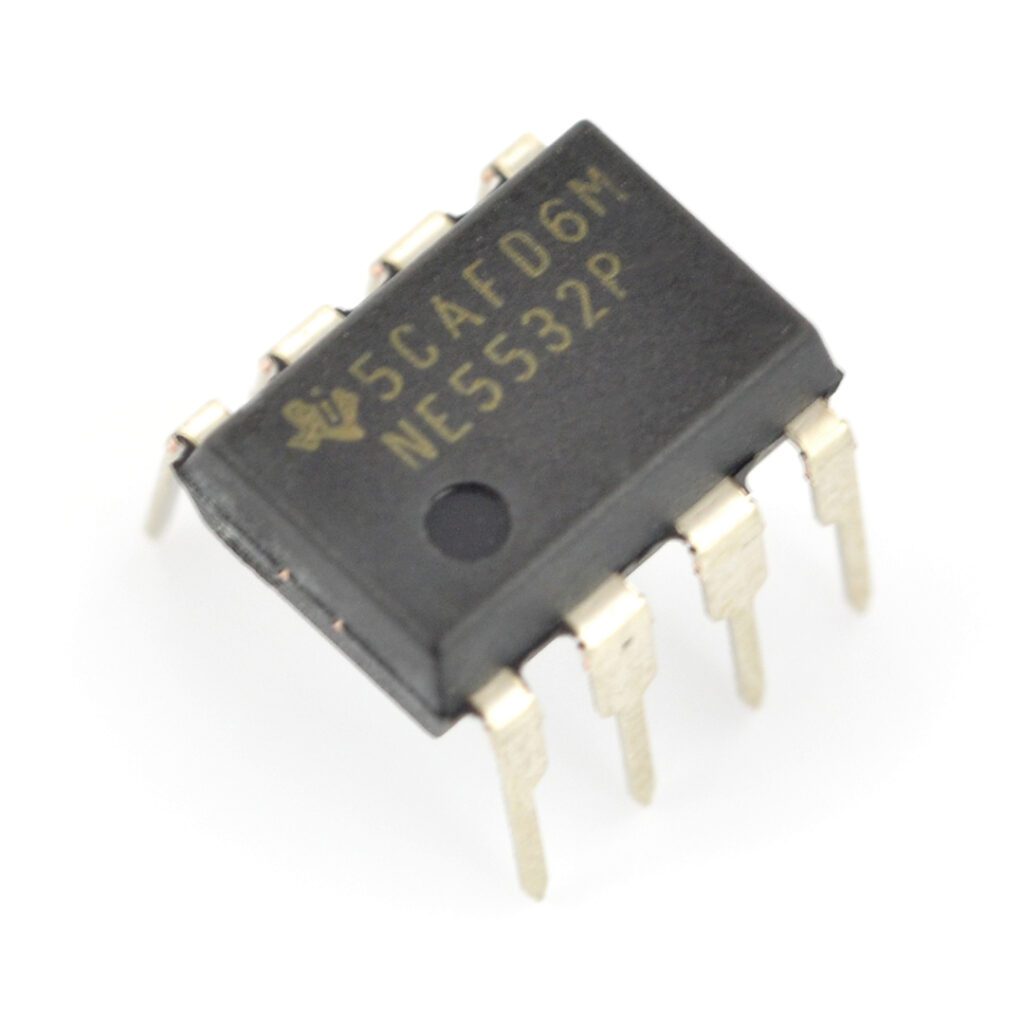Table of Contents:
- 1 Operational amplifier - construction and principle of operation
- 2 Operational amplifier - basic assumptions for an ideal amplifier
- 3 Power supply for the operational amplifier
- 4 The main electrical parameters of the NE5532 operational amplifier
- 5 NE5532 applications
- 6 Guitar preamplifier with NE5532-based buffer.
Operational amplifiers are integral components of most analog electronics circuits, especially in the case of audio circuits. One of the popular circuits in this category is the NE5532. In this article we will look at this IC in detail.
Operational amplifier - construction and principle of operation
The NE5322 integrated circuit was designed by Signetics Corporation in the 1970s. In the 1970s. This chip is manufactured in both through-hole (DIP8) and surface mount (SOIC8) housings. In the structure of the NE5322 IC, two operational amplifiers have been placed. The operational amplifier is one of the most important components in analog electronics, and its field of application is incredibly immeasurable. Sometimes, an operational amplifier is called a “magic triangle” because of its designation on schematics. The name “operational amplifier” stems from the fact that this integrated circuit is designed to perform a variety of mathematical operations – the way the external components are configured, with emphasis on resistors and capacitors, will determine whether the operational amplifier performs addition, subtraction, amplification, logarithmic, integration, differentiation or any other type of required operation. Simply put, an operational amplifier amplifies the difference of voltages applied to its inverting input and non-inverting input.
Operational amplifier - basic assumptions for an ideal amplifier
When analyzing circuits with operational amplifiers, several assumptions must be made. It is assumed that the inputs of an operational amplifier have an infinite input impedance, and therefore do not draw current – in real operational amplifiers, the current drawn by the inputs is on the order of nano-amperes or pico-amperes. An ideal operational amplifier has an infinite DC gain in the open feedback loop – in real systems this value is 106 or even 109 – the limitation here is the auxiliary supply voltage range. In addition, the operational amplifier works in such a way that it seeks to equalize the voltage difference at its inputs. The lack of feedback between the output and one of the inputs would cause the amplifier to quickly enter a cutoff or saturation state, i.e. we would get a voltage at the output close to ground or the rail of the supply voltage, respectively (when the supply is asymmetrical with respect to ground).
Therefore, it is necessary to include external components that provide stabilization of the amplifier through feedback – remember that although the designation on the schematics is the same, the use of operational amplifiers with voltage comparators is not a good idea and can lead to malfunctions in the target circuit.
Power supply for the operational amplifier
An important factor to pay attention to when designing a circuit with an operational amplifier is its power supply. Here we must pay attention to the range of maximum and minimum voltages of the signals that our amplifier is to , “handle”. If we want to feed, for example, a sinusoidal signal to the input of the amplifier, which has negative and positive halves and a peak-to-peak value of 24V, then we need to supply the operational amplifier with a symmetrical voltage of 2x13V, in order to preserve headroom. This is due to voltage drops on the output transistors in the amplifier structure.
What if we only have a single supply available? No problem – it is enough to apply a voltage equal to half the supply voltage to the non-inverting input to shift the signal with a DC component slightly above the ground potential. In the next stages it will be necessary to add a capacitor that removes the DC component from the signal (this is a harmful phenomenon, especially for magneto-electric speakers). If the value of the signal supported by the amplifier’s supply voltage range is exceeded, the amplifier may be overdriven – then distortion in the form of clipping the tops of the signal will appear at the output of the circuit – whether this phenomenon is desirable or not depends solely on the designer’s intention.
The main electrical parameters of the NE5532 operational amplifier
- Equivalent input noise voltage: 5 nV/√ Hz at 1 kHz
- Unit gain bandwidth: 10 MHz
- Co-signal attenuation coefficient: 100 dB
- DC gain: 100 V/mV
- Peak output voltage swing: 32 V with VCC± = ±18 V and RL = 600 Ω
- Voltage ramp-up rate: 9 V/μs
- Supply voltage range: ±3 V to ±20 V
NE5532 applications
- Audio amplifiers
- Tone control systems
- Graphic audio equalizers
Guitar preamplifier with NE5532-based buffer.
The main component of the presented guitar preamp is an NE5532 operational amplifier. The preamp operates with one volume potentiometer and two DPDT on-on switches. One switch is used to change the circuit’s mode, switching between buffer (almost no gain increase) and amp mode. The other switch is used to turn the volume control on and off. In buffer mode, the volume control only allows you to decrease the signal. In amplifier mode, you can manipulate the gain with it.
This type of switching makes it easy to change the gain stage from low to high with a single click. It also allows you to turn down the volume of your guitar without losing frequency response. This is very useful if you want to get a clean sound from a tube amp. For example, when the volume pot is set to 50%, in buffer mode the volume of the guitar is reduced to about 50%, achieving a clean, bright tone without overdriving the tube. In amp mode, when you switch the pedal, the gain is about 50% of maximum. When you switch the pedal from buffer mode to amp mode, you get maximum gain.
The circuit is quite simple and can be implemented on a universal printed circuit board (PCB).
List of components:
- NE5532 operational amplifier
- Potentiometer: logarithmic, recommended values 100k-200k (any value will work to some extent)
- Switches: 2x DPDT on-on
- Electrolytic capacitors: C1, C3, C5: 10 uF
- Fixed film capacitors: C2: 100nF, C4: 560pF
- Resistors:
- R1, R2: 100k
- R3: 1M
- R4: 1k
- R5: 10k (gain = 11), or 20k (gain = 21), or a higher value, even up to 39k – you can experiment with higher values to get more gain and more intense overdrive, but this can introduce unwanted distortion effects.
- R6: 250R
How useful was this post?
Click on a star to rate it!
Average rating 3 / 5. Vote count: 2
No votes so far! Be the first to rate this post.





















